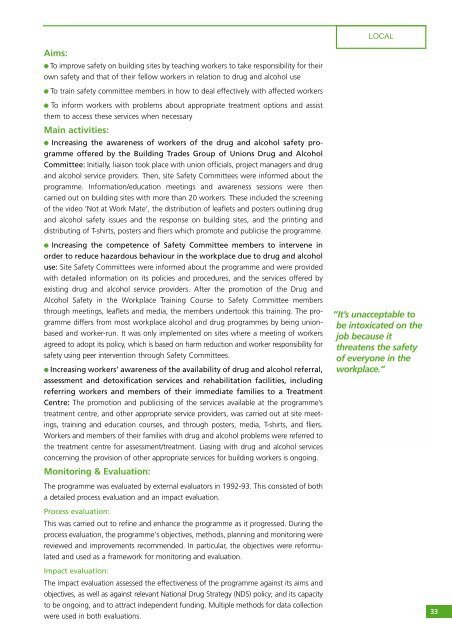PDF (Lessons learned in drug abuse prevention: a global review)
PDF (Lessons learned in drug abuse prevention: a global review)
PDF (Lessons learned in drug abuse prevention: a global review)
Create successful ePaper yourself
Turn your PDF publications into a flip-book with our unique Google optimized e-Paper software.
LOCAL<br />
Aims:<br />
● To improve safety on build<strong>in</strong>g sites by teach<strong>in</strong>g workers to take responsibility for their<br />
own safety and that of their fellow workers <strong>in</strong> relation to <strong>drug</strong> and alcohol use<br />
● To tra<strong>in</strong> safety committee members <strong>in</strong> how to deal effectively with affected workers<br />
● To <strong>in</strong>form workers with problems about appropriate treatment options and assist<br />
them to access these services when necessary<br />
Ma<strong>in</strong> activities:<br />
● Increas<strong>in</strong>g the awareness of workers of the <strong>drug</strong> and alcohol safety programme<br />
offered by the Build<strong>in</strong>g Trades Group of Unions Drug and Alcohol<br />
Committee: Initially, liaison took place with union officials, project managers and <strong>drug</strong><br />
and alcohol service providers. Then, site Safety Committees were <strong>in</strong>formed about the<br />
programme. Information/education meet<strong>in</strong>gs and awareness sessions were then<br />
carried out on build<strong>in</strong>g sites with more than 20 workers. These <strong>in</strong>cluded the screen<strong>in</strong>g<br />
of the video ‘Not at Work Mate’, the distribution of leaflets and posters outl<strong>in</strong><strong>in</strong>g <strong>drug</strong><br />
and alcohol safety issues and the response on build<strong>in</strong>g sites, and the pr<strong>in</strong>t<strong>in</strong>g and<br />
distribut<strong>in</strong>g of T-shirts, posters and fliers which promote and publicise the programme.<br />
● Increas<strong>in</strong>g the competence of Safety Committee members to <strong>in</strong>tervene <strong>in</strong><br />
order to reduce hazardous behaviour <strong>in</strong> the workplace due to <strong>drug</strong> and alcohol<br />
use: Site Safety Committees were <strong>in</strong>formed about the programme and were provided<br />
with detailed <strong>in</strong>formation on its policies and procedures, and the services offered by<br />
exist<strong>in</strong>g <strong>drug</strong> and alcohol service providers. After the promotion of the Drug and<br />
Alcohol Safety <strong>in</strong> the Workplace Tra<strong>in</strong><strong>in</strong>g Course to Safety Committee members<br />
through meet<strong>in</strong>gs, leaflets and media, the members undertook this tra<strong>in</strong><strong>in</strong>g. The programme<br />
differs from most workplace alcohol and <strong>drug</strong> programmes by be<strong>in</strong>g unionbased<br />
and worker-run. It was only implemented on sites where a meet<strong>in</strong>g of workers<br />
agreed to adopt its policy, which is based on harm reduction and worker responsibility for<br />
safety us<strong>in</strong>g peer <strong>in</strong>tervention through Safety Committees.<br />
● Increas<strong>in</strong>g workers’ awareness of the availability of <strong>drug</strong> and alcohol referral,<br />
assessment and detoxification services and rehabilitation facilities, <strong>in</strong>clud<strong>in</strong>g<br />
referr<strong>in</strong>g workers and members of their immediate families to a Treatment<br />
Centre: The promotion and publicis<strong>in</strong>g of the services available at the programme’s<br />
treatment centre, and other appropriate service providers, was carried out at site meet<strong>in</strong>gs,<br />
tra<strong>in</strong><strong>in</strong>g and education courses, and through posters, media, T-shirts, and fliers.<br />
Workers and members of their families with <strong>drug</strong> and alcohol problems were referred to<br />
the treatment centre for assessment/treatment. Lias<strong>in</strong>g with <strong>drug</strong> and alcohol services<br />
concern<strong>in</strong>g the provision of other appropriate services for build<strong>in</strong>g workers is ongo<strong>in</strong>g.<br />
Monitor<strong>in</strong>g & Evaluation:<br />
“It’s unacceptable to<br />
be <strong>in</strong>toxicated on the<br />
job because it<br />
threatens the safety<br />
of everyone <strong>in</strong> the<br />
workplace.”<br />
The programme was evaluated by external evaluators <strong>in</strong> 1992-93. This consisted of both<br />
a detailed process evaluation and an impact evaluation.<br />
Process evaluation:<br />
This was carried out to ref<strong>in</strong>e and enhance the programme as it progressed. Dur<strong>in</strong>g the<br />
process evaluation, the programme's objectives, methods, plann<strong>in</strong>g and monitor<strong>in</strong>g were<br />
<strong>review</strong>ed and improvements recommended. In particular, the objectives were reformulated<br />
and used as a framework for monitor<strong>in</strong>g and evaluation.<br />
Impact evaluation:<br />
The impact evaluation assessed the effectiveness of the programme aga<strong>in</strong>st its aims and<br />
objectives, as well as aga<strong>in</strong>st relevant National Drug Strategy (NDS) policy; and its capacity<br />
to be ongo<strong>in</strong>g, and to attract <strong>in</strong>dependent fund<strong>in</strong>g. Multiple methods for data collection<br />
were used <strong>in</strong> both evaluations.<br />
33
















